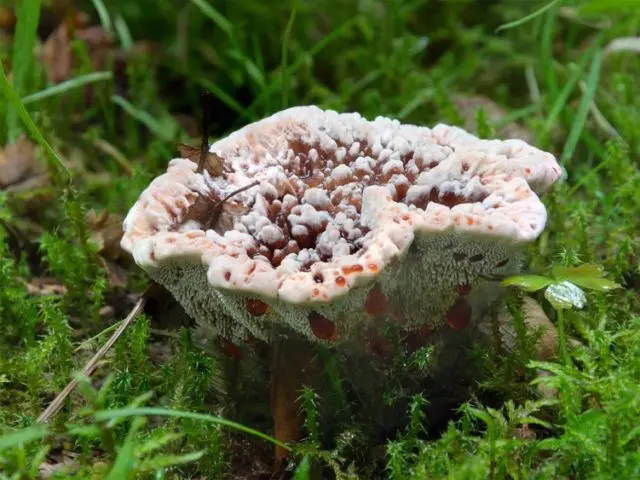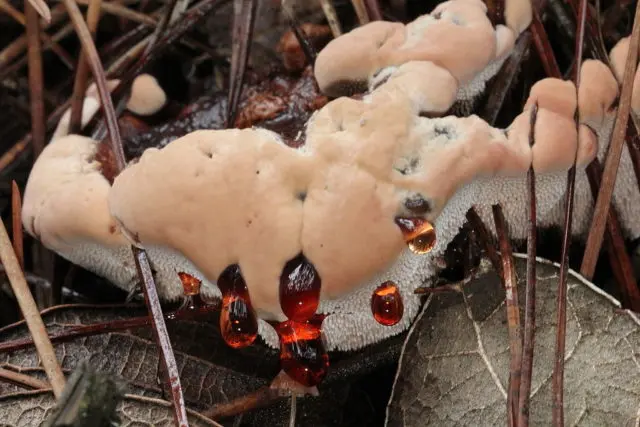Contents
Hydnellum rusty or dark brown is a mushroom of the Bunker family. The fruiting body of this species has a specific structure, slightly resembling a concave thicket on a short stalk. Gidnellum rusty has a unique feature – it overgrows obstacles during growth.
What does rust hydnellum look like?
The fruiting body of the fungus is arranged according to the classical scheme: it consists of a cap and a stem. Sometimes it is difficult to distinguish the transition from one part to another, because due to the special structure of the hymenophore, the separation boundary between them is practically not detected. In some specimens, on the contrary, the leg is well defined and has a relatively long length.
The cap diameter is from 5 to 10 cm, while in the youth of the fungus it is round or club-shaped. With age, a barely noticeable concavity appears on it, and old specimens outwardly resemble a bowl or funnel. The surface of the cap contains a large number of tubercles. However, it is velvety and has an almost uniform texture (with the exception of a harder center).

Adult fruiting body of Hydnellum rusticus
The color of the cap is white when young, changing to light brown with age. Sometimes red or purple drops of a liquid appear on it, which, when dried, covers the rusty hydnellum with spots of various shades of gray.
The pulp of the mushroom is actually two-layered. The outer fibrous shell hides a dense white fabric. In the center of the cap, the flesh is very hard, it has a leathery texture. With the growth of the fruiting body, it envelops various obstacles encountered in the form of branches, stumps and stones.

The inclusion of external objects in the structure of the fungus during the growth of its cap
The leg has a length of about 2-5 cm. Outside, it is covered with a soft tissue with a brownish-brown tint. The structure of the outer layer of the stem is similar in texture to the upper layer of the cap and differs from it only in coloring.
The hymenophore of Hydnellum Rust has a spiny structure. It consists of many segments, several millimeters long, hanging from the underside of the cap. Their color in young mushrooms is white, in mature ones – dark brown or brown. Even with a light touch, the spikes break off. Spores are yellowish in color.
Where does hydnellum rusty grow?
It is found throughout the temperate and subtropical regions of the Northern Hemisphere. Instances of Hydnellum Rust can be found in northern Scotland and Scandinavia. Distributed to the east to the shores of the Pacific Ocean. Extensive habitats are observed in Central Europe, Western Siberia and northern Africa.
Forms mycorrhiza with coniferous trees. Likes mossy types of substrate, as well as strongly acidic soils. They willingly settle on the borders of various types of terrain: forest edges, clearings, along paths. Often it can be seen near a person’s home. Fruiting occurs in mid-summer and lasts until October.
Is it possible to eat hydnellum rusty
According to modern classification, this species is inedible. At the same time, many researchers note a rather strong aroma of fruiting bodies, similar to the smell of freshly ground flour.
Conclusion
Hydnellum rust is an inedible fungus of the Bunker family, widely distributed in the temperate climate of the Northern Hemisphere. A feature of this species is the ability of its fruiting body to overgrow obstacles with an increase in size. The fungus has a thorn-like hymenophore, unusual for many representatives of the Kingdom.









